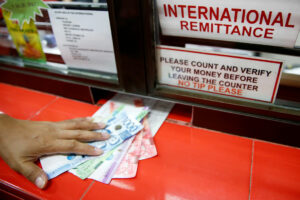




Philippines Trade Update: Exports momentum continues
 DOWNLOAD
DOWNLOAD

Quarterly Economic Growth Release: More BSP cuts to come
 DOWNLOAD
DOWNLOAD

Monthly Economic Update: Fed catches up
 DOWNLOAD
DOWNLOAD


Remittance growth slows in March

Money sent home by overseas Filipino workers (OFWs) in March recorded its slowest pace of growth in nine months, data from the Bangko Sentral ng Pilipinas (BSP) showed.
Cash remittances — which fuels household spending — grew by 2.5% to USD 2.74 billion in March from USD 2.67 billion in the same month last year.
The growth in cash remittances eased from the 3% recorded in February. It was also the slowest pace of annual growth in nine months or since 2.1% in June 2023.
Month on month, cash remittances coursed through banks rose by 3.5% from USD 2.65 billion in February.
“The increase in personal remittances in March 2024 was due to remittances from land-based workers with work contracts of one year or more and sea- and land-based workers with work contracts of less than one year,” the BSP said.
Remittances from land-based workers went up by 3% to USD 2.15 billion in March, while money sent by sea-based workers inched up by 0.9% to USD 588.787 million.
“The slight dip may be attributed to foreign exchange nuances with the peso much weaker in March 2024 versus March 2023,” ING Bank N.V. Manila Senior Economist Nicholas Antonio T. Mapa said in a Viber message.
“Slower inflation for first quarter 2024 versus the corresponding quarter last year could also be tagged as one reason for the slight underperformance,” he added.
In March, inflation accelerated to 3.7% from 3.4% in February. However, it was much slower than the 7.6% print a year earlier.
Rizal Commercial Banking Corp. Chief Economist Michael L. Ricafort noted there was a seasonal increase in remittances due to the “holiday-related spending for the Holy Week in the latter part of March.”
Meanwhile, cash remittances rose by 2.7% to USD 8.22 billion in the first quarter from USD 8 billion in the same period a year ago.
“The growth in cash remittances from the United States (US), Saudi Arabia, the United Arab Emirates (UAE), and Singapore contributed mainly to the increase in remittances in Q1 2024,” the central bank said.
In the January-March period, the United States accounted for 41.2% of overall remittances. This was followed by Singapore (7.2%), Saudi Arabia (5.9%), Japan (5%), and the United Kingdom (4.4%).
Other sources of remittances were the UAE (4.3%), Canada (3.2%), Qatar (2.8%), Taiwan (2.8%) and Hong Kong (2.5%).
Meanwhile, personal remittances increased by 2.6% to USD 3.05 billion in March from USD 2.97 billion in the same month last year. In the first quarter, personal remittances jumped by 2.8% to USD 9.15 billion from USD 8.9 billion a year ago.
Mr. Ricafort said he expects modest growth in remittances in the next few months.
“For the coming months, single-digit growth in OFW remittances could still continue as OFW families still need to cope up with relatively higher prices/inflation locally that would require the sending of more remittances,” he said.
Mr. Mapa said that remittances remain a “stable and dependable source of foreign currency and peso purchasing power for the Philippine economy.”
The BSP expects cash remittances to grow by 3% this year. — By Luisa Maria Jacinta C. Jocson, Reporter
This article originally appeared on bworldonline.com





 By BusinessWorld
By BusinessWorld
